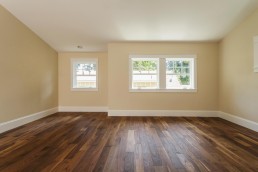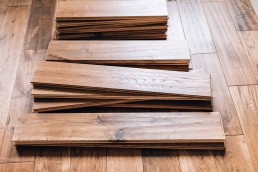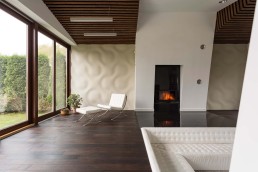5 main differences between solid hardwood and engineered hardwood flooring
One of the most common flooring choices is solid hardwood flooring. It is often made of hardwoods such as maple, oak, or walnut. It also has a substantially longer lifespan, allowing for repeated sanding and refinishing.
Engineered wood flooring resembles hardwood on the surface, but instead of a single wood plank, it is built of a high-quality plywood core with a thin layer of hardwood flooring on top. Engineered wood flooring is less costly, but it cannot be refinished to extend its life. Both surfaces can be utilized throughout the home and offer nearly comparable advantages, making the decision rather personal.
Lifespan
Hardwood flooring has a far longer lifespan than most other forms of flooring. With appropriate upkeep and care, hardwood flooring may endure anywhere from 30 to 100 years. This is why some homes from the 1850s still have hardwood flooring today.
Although engineered hardwood flooring cannot be refinished as frequently as solid hardwood, with careful care, it may last up to 30 years or more. While the entire floor cannot be sanded and refinished, one of the advantages of engineered wood flooring is its ease of replacement, especially when installed using the click-and-lock method.
Installation
The vast majority of solid hardwood floors are nailed to the subfloor. Another common installation method is to link the planks together with tongue-and-groove planks in which each board is blind-nailed. Hardwood flooring must be secured to a subfloor, which is often plywood. The boards are then attached to the subfloor through the tongue, so the nails are hidden when the floor is finished.
Some engineered wood flooring is fastened to the subfloor, in most situations, the click-and-lock mechanism is used for this material. In this installation procedure, tongue-and-groove boards that lock together are used to establish a tight seam. The system floats above the subfloor, which is often composed of foam or cork.
Between the two materials, engineered hardwood is easier to work with than solid hardwood that requires nail down methods. Engineered hardwood is a popular option for DIYers for its ease of use during installation.
Durability and Stability
Both solid hardwood and engineered hardwood offer durability and toughness. However, since solid hardwood is permanently nailed or glued to your subfloor it can be sturdier when compared to engineered hardwood. In contrast, when engineered hardwood is exposed to extreme temperatures it poses greater structural stability because of its resistance to buckling. Overall engineered hardwood does not outperform solid hardwood in durability because the surfaces on engineered hardwood can be thin resulting in being prone to chipping over time.
Water and heat resistance
Both types of hardwood have good resistance to heat. However, both materials are not recommended for homes that are located in wet areas. When assessing solid hardwood, it should not be installed against concrete slabs because of the humidity that goes through this surface. Solid hardwood can warp and swell when exposed to a substantial amount of humidity.
Looking at engineered hardwood it marginally performs better in humid locations since its plywood construction makes it more stable and less prone to warping. In cases where hardwood flooring is required on a concrete subfloor, engineered hardwood would be the flooring to choose.
Environmental considerations
Some consumers prefer to support products that are environmentally friendly. In most circumstances, engineered hardwood floors are more environmentally friendly than solid wood floors. The engineered wood production method is less wasteful and consumes less energy than other flooring options. This is not to argue that choosing solid hardwood is not a sustainable alternative. You may still get environmentally friendly solid wood if you buy it from a reputable provider and it is appropriately certified.
Both solid hardwood and engineered hardwood are great choices for almost any home. Depending on your preference solid hardwood may be a better choice because of its long lifespan, durability, and stability. However engineered hardwood is easier to install making it ideal for DIYers, it has greater resistance to humidity, and engineered hardwood can be more environmentally friendly when compared to other materials. When comparing these materials there are some considerations to be made to assess if one material will suit your needs over the other.
Why You Should Hire A Professional Flooring Installation Company
Changing the floor of your home or business might seem like a simple project that anyone could do. However, a professional flooring company can provide professionalism, their experience, and organization to your project. Ensuring that the floors you want are installed correctly and in a timely manner.
Quality and Faster Installation
If you want your project completed swiftly and effectively, you should choose an experienced flooring contractor. This is because there are various issues that might occur during flooring installation, many DIYers will wind up extending their deadline or blowing their budget if they don't know what they're doing. This is significant when you consider that flooring is the physical foundation of many restorations. It must be completed prior to the installation of trim, cabinets, and wall construction, which means that this step may cause delays in the other stages, and once completed, it is extremely difficult to correct any problems. Hiring a qualified flooring company helps ensure your task will be completed on time. These experts have the skills and knowledge to guide you through even the most difficult projects.
Professional recommendations
You could be undecided about the flooring materials you want to use in your residential or business space. You could also be deciding between the benefits and drawbacks of these materials. If this is the case, this would be the perfect time to speak with a professional flooring company for more information. They are skilled in all flooring materials and can help you decide on one based on your requirements.
Trustworthy, Accountable, and Certified
One of the most important reasons to use a professional flooring installation company is that they are accountable and insured for their work. This means you can trust that they have your best interests in mind. A professional flooring contractor is certified and has been properly trained in both technique and approach. They also follow current industry standards for every job they undertake to ensure the flooring installation is perfect. Hiring a professional flooring company can also help you save money. You will be able to acquire an estimate of the supplies needed, ensuring that you do not overspend.
Project Management
The planning stage in a successful flooring installation can sometimes take up half the project. There can be many steps in planning to install new flooring, some include:
- What flooring type is most suited to the space
- How to demolish, repair, or prepare an area for new floors
- Follow a budget and a timeline
- What to expect throughout the flooring installation
A professional flooring company can assist in making decisions on the best course of action for your remodeling project.
Experience (tricks, tools of the trade/professional point of view)
There are a number of factors that affect the installation of flooring. In some cases, a lack of expertise can lead to serious problems and result in doing a project twice. For example, hardwood flooring must acclimate to the home before installation to avoid gapping or warping. The variable temperature in a home causes this material to expand or contract. Hiring a professional flooring company can help avoid any of these problems. They are also accountable for the project which means they are covered if anything goes wrong on-site.
Flooring can be a difficult project to take on. There are many options, styles, and designs available in the market. A professional flooring company can help you in determining the best floor depending on your needs and preferences A professional flooring company provides experience, accountability, project management, and a faster installation.
5 Types Of Flooring To Consider
The flooring in your home is a major part of your living area, considering that it covers a large part of your home’s interior space. Choosing the right flooring for your home can be a bit overwhelming as there are many types of flooring available to choose from based on your budget and your home’s design.
To assist with your flooring decision we have outlined 5 types of flooring to consider for your home:
Hardwood Flooring
Hardwood flooring is one of, if not, the most popular flooring material used across North America, and for good reason. This type of flooring comes from milled wood, meaning it is made up of 100% wood. With that being said, the types of hardwood flooring can vary from maple to cherry wood and much more. Hardwood is very versatile with many options to choose from. If over the years you find that your hardwood is beginning to look a bit worn, then you have the added bonus of being able to refinish your flooring, making it look brand new again. Hardwood is very durable and strong, which also helps increase the value of your home.Hardwood flooring is one of the more expensive flooring materials that also requires regular maintenance.
Engineered Wood
Engineered wood is the more affordable alternative to hardwood. This type of flooring is a mixture of hardwood and high quality plywood. Like hardwood, it is durable and can last for a long time. One way engineered wood is different from hardwood is that installing engineered wood is more DIY friendly, which can cut down on installation costs. There are drawbacks to engineered wood flooring, for instance,these floors are prone to fading, inconsistent when it comes to quality and they emit VOCs.
Laminate Flooring
Laminate flooring is a popular alternative to hardwood and engineered flooring as it can be made to look like hardwood, but with a much lower price tag.Laminate flooring is made up of particleboard which is overlaid with the image of wood or tile and is then sealed by a protective layer. The protective layer prevents scratches and makes it easier to clean the surface of your flooring. Laminate flooring is another DIY friendly flooring option. One drawback hardwood flooring fans are quick to point out is that laminate cannot replace the hardwood feel with the hollow sound under foot being one of the reasons.
Stone Flooring
Stone flooring is another popular option for homes because of its durability and water resistant properties. Homeowners tend to choose stone for their bathroom, kitchen, basement and even their outdoor spaces. Stone comes in a wide variety or options, like marble, granite and sandstone to name a few. The authenticity and beauty of stone flooring makes it a fan favourite and instant classic for flooring. Like other natural flooring options, it is a bit more expensive than other flooring options and is a bit more intricate to install, it also requires regular maintenance, such as sealing.
Carpeting
Because of its cosy feel, carpeting is a popular option by homeowners for bedrooms and living rooms. Stains used to be an issue that homeowners were weary about, but with modern fabrics, many companies now offer stainless carpeting, while maintaining its affordable pricing. Although there have been improvements made in the cleaning and maintenance aspects of carpeting, it can still be difficult to clean when it gets overly dirty.
With a better understanding of your flooring options, it will be easier to choose which flooring is best suited for your home. The flooring listed above is not a full list of flooring options, if you have questions regarding other flooring options, please consult your local flooring specialists.
5 Differences Between Laminate And Hardwood Flooring
The flooring in your home is not only for functionality, it can add to your home’s aesthetic appeal. For many homeowners, hardwood flooring is considered as the most appealing flooring option, however over the past several decades laminate flooring has grown in popularity and is considered by many as the top flooring option. Hardwood and laminate flooring have similar looks, but they differentiate in structure. As a result of their differences, their installation, maintenance, cleaning and repair also vary. To help highlight the differences between hardwood flooring and laminate flooring, we outline 5 differences between the two below.
1. Material
Hardwood flooring can be made out of solid hardwood or engineered hardwood. Both are natural material sourced from hardwood. On the contrary, laminate flooring is a synthetic product made from fibreboard and resin to form a board. Laminate flooring is finished with a photographic pattern to mimic the look of real wood, especially engineered hardwood, but it is made of composite materials.
2. Cost
Price is another distinguishing factor between genuine hardwood flooring and laminate flooring. Installing hardwood flooring has a higher cost than installing laminate flooring because of the materials used for the installation and the installation process itself.
3. Longevity and Durability
Hardwood flooring is mostly preferred when considering the longevity of both genuine hardwood flooring and laminate flooring. Although both types of flooring are considered durable, hardwood flooring can last up to 80 years while laminate flooring has a life expectancy of about 20 years. Hardwood flooring can be resurfaced and refinished every 10-20 years, which in most cases can be done up to four times before it needs to be replaced. Laminate flooring has the benefit of being less susceptible to scratching, is water resistant and is easier to maintain.
4. Aesthetics
Due to the endless variations of the hardwood grains and stains, hardwood flooring has an extensive collection of looks and patterns as no two real wood planks look identical. Laminate flooring on the other hand has identical patterns that are repeated every few boards. Regardless of how laminate flooring resembles hardwood flooring, the uniqueness and multifarious patterns of hardwood flooring gives itself a more authentic and exciting look.
5. Installation
Most hardwood flooring does interlock together, but there are some nuances to the installation process that are better left to professionals to install. If you are an experienced DIYer, you can try your hand at installing hardwood yourself. Laminate flooring is considered much easier to install as each piece clicks into each other and no specialty tools are required.
Above we explored 5 differences between hardwood flooring and laminate flooring, which should help you make an informed decision when selecting the right flooring option for your home. If you still have questions about the differences between hardwood flooring and laminate flooring visit our Peterborough showroom for more information.
Carpet Selection: Durability, Weight & Style
Purchasing and installing new carpeting in your home or office can come with a few challenges, one of these challenges is choosing the right type of carpet. If you are considering replacing or installing carpet in your home or business, you should consider three important factors – durability, weight, and style of your carpeting. These three factors can make or mar your carpeting.
Here, we will explain what you need to know about durability, weight, and style of carpeting.
Durability
When you want to select a carpet, you need to start by considering its durability. Basically, durability is all about how long your carpet will last without losing its appearance. For a carpet to be durable, the following elements must be of good quality:
1. Fiber
Generally, synthetic or natural fiber is used for making a carpet. The fiber can be used to produce surface/pile or just converted into yarn and tufted. As long as the fiber used for making your carpet is high quality, you can rest assured that it will be durable.
2. Density
Density refers to the number of piles found inside the carpet as well as the closeness of the tufts. Notably, carpets with high density are better and stronger than those with lower density.
You can ascertain the density of a carpet by pressing your fingers on it. If you can reach the backing easily, then the carpet is not very dense, if you are not able to feel the backing, then the carpet is dense and more durable.
3. Twist
This is the method of spinning the fiber filaments of a carpet into yarn and twisting the yarn on itself. When fiber is twisted tightly, it will be difficult for it to lose its original texture and appearance. Consequently, it will be more durable.
Weight
The second important factor to consider when selecting carpeting is weight. Generally, the weight helps you know the number of fibers available in a carpet. When a carpet has lots of fibers, it will be heavier. Hence, you can determine the quality of carpets by comparing their overall weight.
It should be noted that the purpose of the carpeting should be considered. If you need the carpet for residential purposes, its weight should range from about 35 to 60 ounces. However, you should note that higher weight does not necessarily mean higher quality.
Style
Lastly, you need to think about the carpet styles. The three most common types of carpet styles are:
1. Cut pile
When it comes to durability, cut pile carpet is one of the best styles of carpeting. This style is usually recommended for places with high foot traffic. It features tightly twisted, high-density fibers that are highly resilient. Cut pile carpet comes in different styles and can be plush and frieze or velvet and shag.
2. Loop pile
Another common style of carpet is known as loop pile. This style has fibers with unexposed tips; hence, it comes with some sort of loop. Loop pile style has tightly bound fibers that are strong, durable, and capable of withstanding lots of foot traffic. Notably, the fibers of a loop pile carpet can be at the same or different heights.
5. Cut-loop pile
As the name rightly suggests, a cut-loop pile is a type of carpet that boasts of the features of the two other types. As a result of this, cut-loop pile carpet is available in numerous colours, surface textures, and patterns.
How Can I Improve The Life Of My Carpet?
Carpeting has been a staple flooring option for a long time, homeowners enjoy the versatility and comfort of carpeting. However, maintaining your carpets can be quite stressful because they are susceptible to wear-and-tear and staining. There is no need to worry about having dingy looking carpets, or the value of your home dropping because your carpeting is not in tiptop condition. You can maintain your carpets and enjoy the benefits of your capets for years to come.
Ready to keep your carpet looking fresh and new? Here’s how to improve the life of your carpet.
1. Regular Vacuuming
Cleaning and routine maintenance is the best way to keep your carpet in great shape for its lifespan. Vacuum regularly to get rid of dirt and bacteria that can damage your carpet fibers. Use only carpet-friendly cleaning materials to avoid damaging the carpet’s quality or causing it to fade faster than it should.
2. Clean spills and stains instantly
When there are stains, smudges, and spills on your carpet, it is important to attend to them immediately. Clean up any spills on the carpet to prevent it from settling into the material and leaving a permanent discoloration. The longer you leave a spill or stain, the harder it is to get out of the carpet. If you need to use harsh cleaning agents to remove set in stains, they may actually cause more damage to your carpet. Be cautious and conscious about cleaning all stains on your carpet regularly.
3. Make sure your carpet pads are well-fitted
When you step on a carpet, it should feel cushioned. However, after months or years of use, it may start feeling ‘thin’ to walk on the carpet. Carpet pads are what create the cushioned feeling, they lay beneath the carpet and add a barrier between the subfloor and the carpeting. Your carpet pads must always be well-fitted to cover the exact floor space that the carpet covers. The padding keeps the strain of movement off the carpet and allows it to last longer.
4.Invest in a carpet protector
After cleaning your carpet, it is important to apply a carpet protector to make sure your carpets stay clean. The protector also increases the life of the carpet by minimizing the effects of long term use.
5. Make your home a shoe-free zone
The most essential thing to make sure your carpets last as long as you would expect it to, is to apply a shoe-free rule in your home, or at least, on all the carpeted areas. Rough soles, heels, and other parts of shoes can wear into the material of your carpet and reduce its longevity.
Carpets can last up to 10-20 years and with these tips and habits, you can maintain your carpet for the estimated lifespan and keep your home’s interior looking gorgeous! Focus Flooring offers amazing carpet designs and professional installations, contact us to get the best carpeting for your home.
5 Ways Carpets Improve The Air Quality Of Your Home
When most of us think of images that represent poor air quality, we envision factories with large smoke stacks or rush hour traffic with cars idling endlessly. However, the reality is, poor air quality could be found pretty much anywhere, including our homes. This is why taking steps to improve air quality in general is important. One way to help improve the air quality in your home, that most people don’t think of, is by installing a carpet. Carpeting, asides from being a stylish décor, offers many benefits for your indoor air quality. They are an inactive air sift that separates particles and dust from the air you breathe.
Here are five ways through which carpets can improve the air quality of your home.
1. Safe breathing space
Utilizing carpeting throughout your home provides you with an unrestricted circulation of air. The air quality in your home automatically improves with carpeting as dust and other pollutants become trapped in its fibers. With good maintenance of your carpets, you can reduce pollutants and improve the air quality in your home. Some odors and other airborne particles can be toxic and threatening to your lungs and overall health, with carpeting these odors and particles can become trapped, improving the air quality in your home.
2. Traps pollutant in its fibers
As mentioned above, carpets can trap pollutants, they can also trap dust mites, pollens and other everyday pollutants and particles. Simple actions such as walking on your carpet after being outdoors, or spilling liquid on your carpet can lead to the breeding of pollutants, carpets prevent the free flow of polluted particles that can exist in a home by reducing its chances of hovering around.
3. Reduces symptoms of allergies
Individuals with air-related illnesses can breathe better with carpeting. Researchers have discovered with the use of wool carpets in your home as they are hypoallergenic, one can enjoy a better wellbeing. With the regular maintenance of a carpet, symptoms of air-borne allergies were reduced in many individuals. Trapping of pollutants like dust prevents asthma and allergies, among other conditions.
4. Undercover filtering system
Apart from the fact that they remain aesthetically pleasing, carpets are a good filtering system. They collect debris, pollutants like foot dirt and ash. They sift out allergens that linger in your home. Like all filters, carpets do require periodic cleaning to get rid of all the trapped allergens.
5. Helps balance humidity
A good humidity balance in your home helps bring around good indoor air quality. Carpeting can help pull some of the excess moisture from the air, however if there is too much moisture absorbed by your carpeting, it could lead to mold growth and an increase in dust mites. Ensuring your carpets are cleaned regularly, will reduce these side effects of excess moisture.
A clean carpet provides better health and air benefits for your daily living. Take caution to avoid the piling of dirt and rid your carpet of skin cells, pet fur and other allergens by having your carpets cleaned regularly.
5 Reasons Why Carpet Flooring Is Beneficial For Your Home
As a flooring solution carpeting has been a go to for many years, and even though it is not favoured by everyone, many homeowners today still consider carpeting as a top solution for their homes. When it comes to selecting the best flooring for your home, there are several different criteria you need to consider, from design to durability, each homeowner’s needs and wants are different. Below we take a look at carpeting and highlight 5 reasons why carpet flooring is beneficial for your home.
Lower Electricity Bills
The first reason why carpet flooring is beneficial for your home is its ability to lower your energy bills. Carpeting offers excellent insulation, no matter the type of carpet you opt for. The fibers in your carpet trap heat during cold months and prevent cool air from escaping during summer. As a result, your home will be at a more consistent temperature making it more comfortable, and helping reduce your energy bills as your HVAC system will not need to work as hard to maintain your home’s internal temperature.
Privacy
Carpeted flooring absorbs sounds and prevents echoes. Unlike other flooring options that can actually help sound travel further and through other rooms, carpet helps you keep your conversations to yourself and reduce the sound of people walking around your home. A major reason why carpeting is beneficial for your home is its ability to absorb sound waves. This applies to any form of sound, including voices, music, and footsteps.
Comfort
An obvious reason why carpet flooring is beneficial for your home is the improved comfort and support it provides. Carpeting gives more flexibility underfoot than other flooring solutions. Carpet flooring acts as a shock absorber and protects your feet and joints from impact. As a result, carpeting will offer a more comfortable surface to stand or walk on than other hard flooring surfaces.
Safety
Carpeting is a top choice for homeowners who want a safer, non-slip surface in their homes. Hard surfaces can quickly become slippery, which increases the chances of accidents. Carpet offers a textured surface that can help prevent falls, especially on stairs. Homes with younger children or elderly individuals can benefit from carpet, and just in case there is a trip and fall on carpet, it is a bit more forgiving than other flooring options such as hardwood or tile.
Affordability
Another reason why carpet flooring is beneficial for your home is the price. Carpeting is considered one of the more affordable flooring solutions available on the market. It can be set up over numerous types of subfloors, and can be installed fairly quickly. Carpet is a budget friendly solution, both on the material and on the installation.
The above are just 5 of the many reasons why carpet flooring is beneficial for your home. If you have questions about utilizing carpet in your home, we recommend you discuss with one of our carpeting experts before choosing a flooring solution. They can help you decide on if carpet is the right solution for your home and what type of carpet will meet your design and usage needs.
5 Tips for Taking Care of Your Floor Tiles
Many homeowners choose ceramic tile for their homes as they are some of the most durable tiles. They are available in a wide range of designs and styles for the best possible aesthetic match for your home. A big benefit of ceramic floor tiles is that they require very little maintenance and are super resilient, giving you the best value for your dollar.
There is however some maintenance required to ensure your tiles remain in great condition for years to come. Below we highlight some of the required care.
Tip 1. Clean spills and stains
The most important thing to remember when caring for your tiles is that, nothing should get the opportunity to stick or settle for a long time. As soon as dirt and spills happen, jump into action and wipe them up because if the spill settles in, it has the potential of staining the surface of your tiles, and that is not a look that you want. You can’t prevent spills and dirt from ending up on your floors, but if you clean them as soon as they happen, your tiles will never stop looking fabulous!
Tip 2. Avoid oily or soapy cleaning solutions
You can wipe your tiles regularly with a damp towel or sponge, but you should avoid using oily cleaning solutions, especially on ceramic tiles. Oily solutions may cause the tiles to become slippery, leading to accidents and potential injuries. Just sweep the surface of your tiles and use warm water and manufacturer recommended cleaning products to clean your tiles. You can also mix a cup of white vinegar and a gallon of water to get an odor-eliminating solution. This all-natural solution is also extremely safe for homes where you have children or pets.
Tip 3. Seal your grout
The installation of ceramic tiles is completed with grout that holds it in place. The grout can get dingy after long periods of use, but you can preserve the grout by sealing it after the tiles are installed. Sealing gives it a longer range before any discoloration can have the opportunity to set in. Protecting your grout also protects your tiles, so it is a win-win.
Tip 4. Bleach and clean grout regularly
Tile grout is typically white and over time, it can darken and become discolored. When you clean your tiles, the grout also gets cleaned. But, if you need to get rid of the dinginess, you can clean it with commercial products or bleach the grout if it still looks stained or discoloured. You can mix about 250ml of regular bleach with 2 litres of water and scrub the grout before rinsing.
Tip 5. Replace cracked tiles
Cracked tiles are an accident waiting to happen and they should be treated with urgency. If you notice cracks in your tiles, be sure to remove the damaged tile and replace with a new tile. Don’t forget to apply grout after replacing the tile and seal the grout to preserve and protect it. If you are not comfortable removing your old tiles and installing replacement ones, contact your local flooring specialist for assistance.
Though floor tiles, especially ceramic tiles, are quite easy to maintain, these above tips will make taking care of your tiles an easy task.
How Long Does It Take To Replace Hardwood Floors?
Are you planning to replace your hardwood floors? If yes, you will realize that replacement requires lots of planning. While planning, you will probably want to know how long it will take you to replace hardwood floors.
You don’t want to wait around for several weeks without being able to use your home properly. However, you should note that there are many factors involved in determining the duration of replacing hardwood floors.
Basically, it will take around 1 – 3 days to install the floor depending on its size. However, due to the need for hardwood acclimation and other things, you will need about 8 – 10 days to complete the whole process.
A typical timeline for replacing hardwood floors
Replacing hardwood flooring usually involves some basic steps. So, let’s take a look at each step and how long it will take.
Step 1: Removal of old hardwood floor
As expected, you need to remove the old hardwood flooring before installing a new one. Unless the space is large, this should be completed in a few hours by a professional hardwood floor installer.
Step 2: Acclimation
To ensure that the hardwood floor blends with its new environment, there is a need for acclimation. At this stage, the installer will bring the new flooring items into your home and allow them to breathe. With proper acclimation, hardwood floor replacement will be a walk in the park.
The hardwood flooring materials should be allowed to acclimate for some days. Although you may want to rush things, failure to acclimate can jeopardize the whole flooring replacement. So, make sure the acclimation lasts for about 7 or more days.
Step 3: Installation of new flooring
Once the process of acclimation is complete, the hardwood flooring contractor will prepare the subflooring. This process can also add a few hours or days to the time it will take to replace your hardwood flooring.
Afterwards, the contractor will install a new hardwood floor. The number of hardwood flooring installers and the size of the room are the major factors that will determine the duration of the installation. While an experienced installer will need about 2 days to install hardwood floors in a room of 750 to 1,000 square feet, a team of two installers will need only one day. Additionally, the presence of fireplaces, cabinets, and other obstacles in the job site can extend the timeline for replacing hardwood flooring. Therefore, you must get rid of obstacles that can affect the works of the installers.










